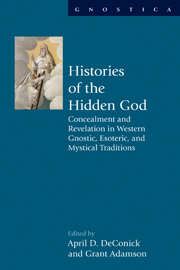 Histories of the Hidden God
Histories of the Hidden God Book contents
- Frontmatter
- Contents
- Acknowledgments
- Contributors
- Introduction: In search of the hidden God
- Part I Concealment of the Hidden God
- 1 Who is hiding in the Gospel of John? Reconceptualizing Johannine theology and the roots of Gnosticism
- 2 Adoil outside the cosmos: God before and after Creation in the Enochic tradition
- 3 The old gods of Egypt in lost Hermetica and early Sethianism
- 4 Hidden God and hidden self: The emergence of apophatic anthropology in Christian mysticism
- 5 God's occulted body: On the hiddenness of Christ in Alan of Lille's Anticlaudianus
- Part II The Human Quest for the Hidden God
- Part III Revelations of the Hidden God
- Afterword: Mysticism, Gnosticism, and esotericism as entangled discourses
- Bibliography
- Index
3 - The old gods of Egypt in lost Hermetica and early Sethianism
from Part I - Concealment of the Hidden God
- Frontmatter
- Contents
- Acknowledgments
- Contributors
- Introduction: In search of the hidden God
- Part I Concealment of the Hidden God
- 1 Who is hiding in the Gospel of John? Reconceptualizing Johannine theology and the roots of Gnosticism
- 2 Adoil outside the cosmos: God before and after Creation in the Enochic tradition
- 3 The old gods of Egypt in lost Hermetica and early Sethianism
- 4 Hidden God and hidden self: The emergence of apophatic anthropology in Christian mysticism
- 5 God's occulted body: On the hiddenness of Christ in Alan of Lille's Anticlaudianus
- Part II The Human Quest for the Hidden God
- Part III Revelations of the Hidden God
- Afterword: Mysticism, Gnosticism, and esotericism as entangled discourses
- Bibliography
- Index
Summary
Amun, the name of the Egyptian god, means hidden, and the utterly transcendent deity in Eugnostos is described likewise. This could be attributed immediately to coincidence if it were not for several other points of interest in the text. First, the theogony in Eugnostos arguably once featured the same number of single and paired gods as found in the Khonsu Cosmogony, an Egyptian monumental source from the Ptolemaic period. Second, in Eugnostos these gods are referred to by Hermetic terms of generation, namely unbegotten, self-begotten, begotten and so on. Third, the cosmos that the gods in Eugnostos produce is manifestly that of the decans who govern the thirty-six weeks of the year in the Egyptian calendar.
That such cosmological and calendrical assumptions are made in Eugnostos is enough to wonder to what extent the text may be neither Christian nor Jewish: whereas Egyptians kept a ten-day week marked by the rising of a decan, Jews and Christians observed a seven-day week in accordance with the Decalogue. This is not to deny the influence of Jewish literature on the text at some stage of composition; indeed, the author of this didactic letter and for whom it is named could have been a Hellenized Jew living in Egypt, such as one of Philo's extreme allegorizers unconcerned with the Sabbath. But as for the early church, in Roelof van den Broek's words, “I am unable to see any distinct and indisputable Christian influence.”
- Type
- Chapter
- Information
- Histories of the Hidden GodConcealment and Revelation in Western Gnostic, Esoteric, and Mystical Traditions, pp. 58 - 86Publisher: Acumen PublishingPrint publication year: 2013
